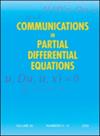Asymptotics and scattering for wave Klein-Gordon systems
IF 1.7
2区 数学
Q1 MATHEMATICS
Communications in Partial Differential Equations
Pub Date : 2023-09-02
DOI:10.1080/03605302.2023.2263205
引用次数: 2
Abstract
AbstractWe study the coupled wave-Klein-Gordon systems, introduced by LeFloch-Ma and then Ionescu-Pausader, to model the nonlinear effects from the Einstein-Klein-Gordon equation in harmonic coordinates. We first go over a slightly simplified version of global existence based on LeFloch-Ma, and then derive the asymptotic behavior of the system. The asymptotics of the Klein-Gordon field consist of a modified phase times a homogeneous function, and the asymptotics of the wave equation consist of a radiation field in the wave zone and an interior homogeneous solution coupled to the Klein-Gordon asymptotics. We then consider the inverse problem, the scattering from infinity. We show that given the type of asymptotic behavior at infinity, there exist solutions of the system that present the exact same behavior.KEYWORDS: AsymptoticsScattering from infinityWave-Klein-Gordon systems Notes1 In fact, u3 would be zero if we only consider the term ϕ02. The presence of u3 comes from the lower order terms in (∂tϕ0)2.2 We use the Einstein summation convention. Also, when the repeated index is spatial, we define the expression to be the sum regardless of whether it is upper or lower, as the spatial part of the Minkowski metric is Euclidean.3 Here we use the decay |△yϕ|≲ερ−32+δ(1−|y|2)74−δ, for which we only have it with 47 replaced by 45 at this stage, but this can also be shown by dealing with commutators like the existence proof.4 Recall in Lemma 4.5, we require that α cannot be too worse. i.e. close to –1. However, once α satisfies this condition, the value of α does not affect the outcome of the estimate.5 Note that here we take the contribution from (∂tϕ)2 into account, which we did not consider in the introduction part for simplicity.Additional informationFundingH.L. was supported in part by Simons Collaboration Grant 638955. X.C. thanks Junfu Yao for helpful discussions.波Klein-Gordon系统的渐近性和散射
摘要本文研究了由LeFloch-Ma和Ionescu-Pausader引入的耦合波-克莱因-戈登系统,在调和坐标系下对爱因斯坦-克莱因-戈登方程的非线性效应进行建模。我们首先考虑基于LeFloch-Ma的略为简化的全局存在性,然后推导出系统的渐近行为。Klein-Gordon场的渐近性由修正相位乘以齐次函数组成,波动方程的渐近性由波区辐射场和与Klein-Gordon渐近性耦合的内部齐次解组成。然后我们考虑反问题,从无穷远处的散射。我们证明了给定系统在无穷远处的渐近行为类型,存在具有完全相同行为的解。注1事实上,如果我们只考虑项ϕ02,则u3将为零。u3的存在来自于(∂tϕ0)2.2中的低阶项,我们使用爱因斯坦求和约定。同样,当重复指标是空间的时,我们将表达式定义为和,而不管它是上还是下,因为闵可夫斯基度规的空间部分是欧几里得的。3这里我们使用衰减|△yφ |≤ερ−32+δ(1−|y|2)74−δ,在这个阶段我们只把47替换为45,但这也可以通过处理交换子来证明,如存在性证明回想引理4.5,我们要求α不能太差。即接近-1。然而,一旦α满足这个条件,α的值不影响估计的结果请注意,这里我们考虑了(∂tpφ)2的贡献,为了简单起见,我们在介绍部分没有考虑到这一点。额外的informationFundingH.L。得到了西蒙斯合作基金638955的部分支持。X.C.感谢姚俊富的讨论。
本文章由计算机程序翻译,如有差异,请以英文原文为准。
求助全文
约1分钟内获得全文
求助全文
来源期刊
CiteScore
3.60
自引率
0.00%
发文量
43
审稿时长
6-12 weeks
期刊介绍:
This journal aims to publish high quality papers concerning any theoretical aspect of partial differential equations, as well as its applications to other areas of mathematics. Suitability of any paper is at the discretion of the editors. We seek to present the most significant advances in this central field to a wide readership which includes researchers and graduate students in mathematics and the more mathematical aspects of physics and engineering.

 求助内容:
求助内容: 应助结果提醒方式:
应助结果提醒方式:


